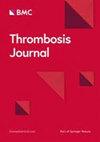下腔静脉滤器植入后早期急性腔静脉血栓形成导致阻塞性休克:病例报告和文献综述
IF 2.6
4区 医学
Q2 HEMATOLOGY
引用次数: 0
摘要
阻塞性休克在临床实践中极为罕见,它是由全身或肺循环中心血管的急性血流阻塞引起的。使用下腔静脉滤器(IVCF)预防肺栓塞(PE)可能会引起一些并发症,如下腔静脉血栓形成(IVCT)。IVCT 直接导致休克的情况并不多见。我们介绍了一例在置入 IVCF 后由于抗凝治疗不充分而导致广泛 IVCT 继发阻塞性休克的病例。一名 63 岁的男性患者因交通事故受伤,导致骨科创伤和下肢深静脉血栓形成(DVT)。在置入 IVCF 5 天后和停止抗凝治疗 3 天后,他突然出现剧烈腹痛,并伴有低血压、心动过速、呼吸过快、少尿和外周水肿。考虑到经验性抗休克治疗持续时间较长,疗效不佳,我们最终通过影像学检查结果--下腔静脉血栓形成和闭塞--确认了受累血管,并聚焦于梗阻性休克的原因。血栓抽吸后,休克状态立即缓解。6 天后,在从重症监护室转入普通病房的过程中,再次发生了同样类型的休克,并进行了同样的治疗。患者后期恢复顺利,术后 1 个月、3 个月和 12 个月的随访显示效果良好。本病例提醒临床医生,IVCF置入术后确保充分的抗凝治疗至关重要,当患者术后出现低血压、心动过速、下肢和阴囊水肿等症状时,应立即考虑梗阻性休克的可能性,并根据病因及时进行干预。本文章由计算机程序翻译,如有差异,请以英文原文为准。
Acute caval thrombosis leading to obstructive shock in the early post insertion period of an inferior vena cava filter: a case report and literature review
Obstructive shock is extremely rare in clinical practice and is caused by acute blood flow obstruction in the central vessels of either the systemic or pulmonary circulation. Utilizing inferior vena cava filters (IVCFs) to prevent pulmonary embolism (PE) is associated with some potential complications, such as inferior vena cava thrombosis (IVCT). Shock as a direct result of IVCT is rare. We present a case of obstructive shock secondary to extensive IVCT caused by inadequate anticoagulant therapy after the placement of an IVCF. A 63-year-old male patient with a traffic accident injury presented orthopaedic trauma and lower limb deep vein thrombosis (DVT). He experienced sudden and severe abdominal pain with hypotension, tachycardia, tachypnea, oliguria and peripheral oedema 5 days after IVCF placement and 3 days after cessation of anticoagulant therapy. Considering that empirical anti-shock treatment lasted for a while and the curative effect was poor, we finally recognized the affected vessels and focused on the reason for obstructive shock through imaging findings—inferior vena cava thrombosis and occlusion. The shock state immediately resolved after thrombus aspiration. The same type of shock occurred again 6 days later during transfer from the ICU to general wards and the same treatment was administered. The patient recovered smoothly in the later stage, and the postoperative follow-up at 1, 3, and 12 months showed good results. This case alerts clinicians that it is crucial to ensure adequate anticoagulation therapy after IVCF placement, and when a patient presents with symptoms such as hypotension, tachycardia, and lower limb and scrotal oedema postoperatively, immediate consideration should be given to the possibility of obstructive shock, and prompt intervention should be based on the underlying cause.
求助全文
通过发布文献求助,成功后即可免费获取论文全文。
去求助
来源期刊

Thrombosis Journal
Medicine-Hematology
CiteScore
3.80
自引率
3.20%
发文量
69
审稿时长
16 weeks
期刊介绍:
Thrombosis Journal is an open-access journal that publishes original articles on aspects of clinical and basic research, new methodology, case reports and reviews in the areas of thrombosis.
Topics of particular interest include the diagnosis of arterial and venous thrombosis, new antithrombotic treatments, new developments in the understanding, diagnosis and treatments of atherosclerotic vessel disease, relations between haemostasis and vascular disease, hypertension, diabetes, immunology and obesity.
 求助内容:
求助内容: 应助结果提醒方式:
应助结果提醒方式:


